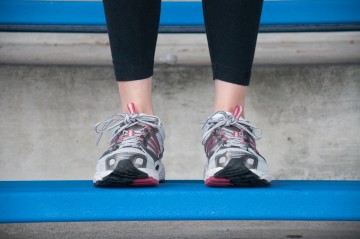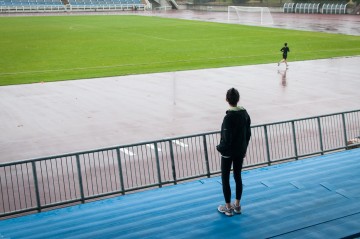I’m often asked to shoot illustrative photos that depict concepts or moods rather than real-time events. In my photography, I’m used to reacting to what’s around me, but fully constructing an image requires some imagination, and it isn’t always easy. When I was told last October the upcoming feature would be about an athlete who stopped menstruating, I knew it would be a difficult week.
Needless to say, the story posed several photographic challenges. The subject of the article did not wish to be identified (so a straight portrait could not be done), the subject matter was incredibly delicate and the timeline was tight.
I requested an advance copy of the article to give me a better understanding as to what the story was about and what the emotional angle was. After all, when you’re given a topic like “amenorrhea,” having some context can really help. After reading it, I remember being fascinated by the loneliness, dejection and other emotions associated with being medically unable to play a sport.
Throughout the week, I racked my brains for something, anything. During a meeting, someone had suggested that I just take a photo of an empty stadium, but because I did not have a wide lens at the time, I couldn’t do the space justice. The story is incredibly personal, and to not have a human in the photo seemed odd to me. As Joe McNally once said to landscape photographer Moose Peterson, “I never met a landscape I couldn’t make better by putting a person in front of it.”
During my most desperate hour, I thought of just using a dumbbell to crush a tampon, but it was crude and I was thinking too literally, as usual. It had to be more subtle than that.
The day before the final print deadline, I still had no idea what I was doing, but I was out of time and I needed a picture. I enlisted the help of one of my colleagues at the paper to serve as my model and I made sure she brought running shoes. We went to the track at Centennial Stadium and started to walk around. It was a cold October afternoon and it was drizzling ever so slightly. I saw a stack of hurdles on the track and wondered if I could frame my subject in them. It didn’t work. The hurdles were too dominant in the frame, and the background was less than inspiring. Next I tried to shoot a closeup of her runners, but they were too static if she was just standing there. How could I convey loneliness when I couldn’t show a face?
After half an hour of wasted frames, I was just about ready to pack it in when, as luck would have it, a lone runner began jogging the length of the track. It was raining harder now, and there was no one else there. My model already had her back turned to me, and in that instant I finally figured out how I wanted to shoot it. It wasn’t about athletic prowess (as the prior attempts would have illustrated); it was about dashed hopes. I thought if I could have my model look forlornly at someone who could do what she could not given her condition, it could better convey an emotional part of the feature. The long lines created by the track and the benches were a convincing bonus.
I asked my model to shift her weight to her right foot, put her left hand in her pocket (for visual balance) and follow the runner as he passed by her. I shot six frames with the runner in various parts of the photo, but given my camera angle and composition, I went with this one, and as luck would have it, it was the only one to work as a right-page vertical crop. For better or for worse, I crop loosely by nature, and in this instance it gave the design team more flexibility as photos often have to have enough dead space to be cropped to fit a particular layout, while still looking good as shot.
When I shot this at the end of October, I never imagined myself as being good at constructing these kinds of scenes. As a confirmed introvert, it just didn’t sound like my thing, but having done this a few times, having control over every aspect of the scene is actually kind of empowering. It certainly wouldn’t be the last time that I ended up enjoying an assignment that I dreaded at first.
Read the original article here.
Metadata: Nikon D300, Nikkor 35mm f/1.8 DX @ f/2.8, 1/1250 sec, ISO 800.










